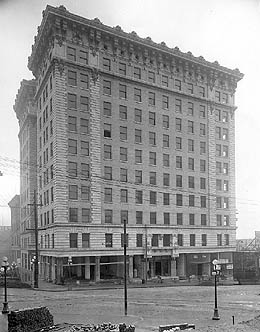When it was new in 1911, the Frye Hotel, designed by Charles Herbert Bebb (1856-1942) and Louis Leonard Mendel (1867-1940), was described by consensus as simply the finest hotel in Seattle. It was also one of the highest of the city’s new steel-frame brick and terra-cotta tile skyscrapers. Eleven stories up, the grandly ornamented cornice overflows like a fountain at the cap of this elegant Italian Renaissance landmark. It was built by Seattle pioneer George F. Frye (1833-1911) and his wife Louisa (Denny) Frye.
The Frye Hotel was the last of George Frye’s many accomplishments. Arriving in Seattle in 1853, the 20-year-old German immigrant helped Henry Yesler assemble his steam sawmill and quickly became a favorite of Arthur and Mary Denny and later also of their daughter. Louisa had just turned 17 when George married her in 1860. Together they had six children and many businesses, and Louisa was very much a partner in both. The children recalled how their father would never make a major business decision without the review and approval of their mother.
These partners ran the first meat market in Seattle, opened a bakery, raised the city’s first distinguished stage, the Frye Opera House. George Frye also organized the community's first brass band, built and managed at least three hotels, and invested in real estate, all with great success.
For four years beginning in 1870, George Frye was also first purser and then captain of the Puget Sound steamer J.B. Libby when it had the federal contract to deliver mail to Whidbey Island and other points north.
Typically, the Fryes formed their own contracting company to build their grandest hotel and George, entering his late 70s, managed the construction. A little more than a year after the hotel’s grand spring opening in 1911, George F. Frye died. His widow, of course, continued to manage the Louisa C. Frye Hotel. George had named it for her.
Although built near the train depots to the south the commercial heart of the city was already moving north from Pioneer Square when the Frye Hotel was opened.
In the early 1970s, the hotel was converted into low-income apartments. Most recently the Low Income Housing Institute (LIHI) has purchased the hotel, restored the marble grandeur of its main floor, strengthened it against earthquakes, and repainted and reappointed its 234 units.

